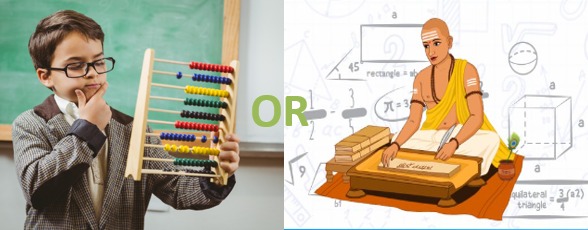Abacus and Vedic Mathematics: A Comparative Analysis
In the quest for mathematical excellence, various techniques and tools have emerged to enhance mental calculation skills. Abacus and Vedic Mathematics are two popular methods that offer unique approaches to boost mathematical proficiency. In this blog, we will explore the key aspects of both techniques and delve into a comparative analysis to help you determine which one might be better suited for your mathematical journey.
Abacus: Unleashing the Potential of Ancient Calculation Tools

The abacus utilizes the ancient abacus, a counting device consisting of rows of beads, to develop mental math skills.
Let's examine some key features of Abacus
- Visual and Tactile Learning: The abacus engages multiple senses, combining visual and tactile learning. Manipulating the beads on the abacus promotes a hands-on learning experience, aiding in the understanding of mathematical concepts.
- Step-by-Step Approach: Abacus typically follows a structured step-by-step learning process, starting with basic arithmetic operations and gradually advancing to more complex calculations. This systematic approach ensures a strong foundation for mental math skills.
- Speed and Accuracy Focus: Abacus emphasizes both speed and accuracy. Regular practice with the abacus improves calculation speed, mental agility, and accuracy, enabling users to perform computations swiftly and precisely.
Vedic Mathematics: Discovering Ancient Indian Mathematical Techniques

Vedic Mathematics is based on ancient Indian mathematical principles found in the Vedas, sacred texts of Hinduism. Here are some notable aspects of Vedic Mathematics:
- Simplicity and Efficiency: Vedic Mathematics offers simplified techniques and strategies to perform calculations. It presents elegant and concise methods that allow users to solve complex mathematical problems quickly.
- Versatility and Applicability: Vedic Mathematics covers a wide range of mathematical concepts and provides versatile techniques applicable to various domains of mathematics. It offers alternative methods for arithmetic, algebra, calculus, and more.
- Mental Calculation Emphasis: Vedic Mathematics emphasizes mental calculation, encouraging users to solve problems mentally rather than relying on traditional paper-and-pencil methods. It develops mental agility, enhances mathematical intuition, and promotes quick thinking.
When considering which approach is better, Abacus or Vedic Mathematics, it is crucial to examine various factors based on individual preferences and goals

- Learning Style: Abacus incorporates visual and tactile elements, making it suitable for individuals who benefit from hands-on experiences. Vedic Mathematics, on the other hand, focuses on mental strategies and appeals to those who prefer cognitive approaches.
- Mathematical Scope: If your goal is to explore a broader range of mathematical concepts beyond basic arithmetic, Vedic Mathematics provides a comprehensive set of techniques applicable to various mathematical domains.
- Cultural Significance: Vedic Mathematics holds cultural and historical significance, as it derives from ancient Indian mathematical traditions. Exploring Vedic Mathematics can offer a deeper understanding of mathematical heritage and its philosophical underpinnings.
- Speed vs. Versatility: Abacus places significant emphasis on speed and accuracy, making it a suitable choice for competitions or situations where rapid calculations are required. Vedic Mathematics, while promoting mental agility, offers versatile techniques that can be applied to various mathematical problems.
Conclusion
Both Abacus and Vedic Mathematics are powerful methods for developing mental calculation skills and enhancing mathematical proficiency. The choice between the two ultimately depends on individual preferences, learning styles, and mathematical goals. Abacus excels in visual and tactile learning, while Vedic Mathematics offers versatile techniques applicable to a wide range of mathematical concepts. Exploring both approaches can provide a holistic mathematical foundation and cater to different learning preferences. Remember, the key to success lies in consistent practice and finding an approach that resonates with you.






